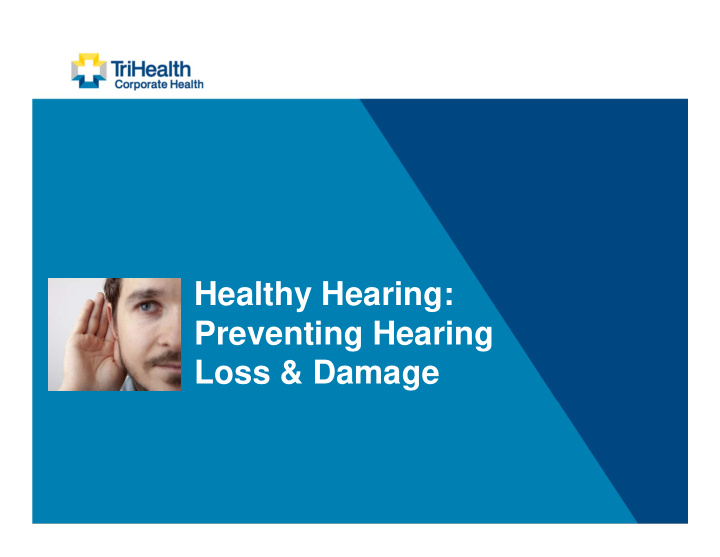



Healthy Hearing: Preventing Hearing Loss & Damage
Healthy Hearing: Preventing Hearing Loss & Damage Tune In: Tips for une In: Tips for Better Better Hearing Hearing About 20 percent of adult Americans experience some degree of hearing loss, and one in three people over age 65 has hearing loss, according to the Hearing Loss Association of America. Take These These Steps to Steps to Help Pr Help Protect otect Your Hearing ur Hearing: : 1. Wear ear plugs when you are exposed to loud noises. 2. Use a moderate volume for devices you put in your ears. 3. Do not use Q-tips (cotton swabs) in your ears, which can cause wax buildup and lessen hearing. 4. Get a hearing test, especially if you experience hearing loss in just one ear. Chances of correcting hearing loss increase with early intervention.
Healthy Hearing: Preventing Hearing Loss & Damage Hearing Loss Pr Hearing Loss Prevention on the Job evention on the Job Occupational hearing loss is defined as noise-induced hearing loss due to overexposure in the workplace and considered one of the most common occupational illnesses in the United States according to the Better Hearing Institute. Pr Protect otect Your Hearing on ur Hearing on the Job the Job: : Learn Learn about your employer’s hearing conservation program if you work at an at-risk occupation. These programs strive to prevent hearing loss and equip workers with hearing protection devices. We Wear hearing protection such as earplugs consistently when using or near loud equipment at work. Limit Limit exposure to hazardous noise, both on the job and at home. See See a hearing health professional routinely for hearing testing.
Healthy Hearing: Preventing Hearing Loss & Damage Swimmer’s Ear: What Y Swimmer’s Ear: What You Need to Know u Need to Know Swimmer’s ear differs from other ear infections such as the kind that accompany a cold or sinus infection, which affect a deeper part of the ear canal. Swimming is the primary, but not the only, cause of swimmer’s ear. Showering, rain water, heavy sweating, and high humidity also can be culprits. Symptoms of Swimmer’s Ear often include: Pain when pushing or pulling on the ear Redness Swelling Treatment often is as simple as using ear drops containing antibiotics for 10-14 days. If you tend to get Swimmer’s Ear often, take these precautions: Remove water from your ear, when needed, with a tissue or by shaking your head sideways. Use over-the-counter drops, which usually contain a combination of alcohol and vinegar.
Recommend
More recommend